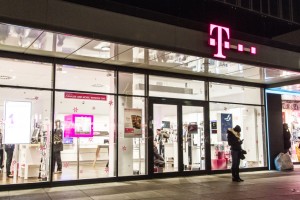T-Mobile’s BingeOn™ Lemonade Stand Satiates Shareholder Thirst
1. At heart, it’s all about network anti-congestion strategies.
We’ve got to hand it to T-Mobile – they’ve been trying hard to market their shortcomings, such as network gaps and spectrum position relative to other wireless service providers, as advantages. T-Mobile was the first of the Big Four telecoms to offer WIFI calling, connecting phone calls via local WIFI networks instead of using its cellular LTE infrastructure. In mid-November T-Mobile unveiled Binge On™, a video streaming platform that would allow its customers unlimited streaming for free. In areas where T-Mobile’s LTE service is not already up and running, the innovative company has pledged to install LTE CellSpots (femtocells) into users’ homes – also for free.

What a cunning play by T-Mobile – one that adds customers in areas where optimized cellular infrastructure is lacking. Keep in mind that this new user base could receive the same level of quality by connecting to their Wi-Fi networks, so the advantage is almost exclusively in T-Mobile’s corner. Both of T-Mobile’s recent campaigns share a common objective, which is to alleviate congestion on its cellular network by “offloading” backhaul to Wi-Fi networks and/or customers’ home CellSpots, thereby enabling T-Mobile time to further build out its cellular network and purchase much-needed RF spectrum. T-Mobile’s Binge-On™ video streaming initiative positions its subscribers to easily access free (but significantly reduced quality) video technology instead of consuming cellular data via their unlimited or high GB data plans.
2. The Data Tsunami requires constant innovation.
According to Netflix, streaming HD quality video uses approximately 3GB per hour; while Ultra HD consumes 7GB per hour – more than double. Currently, some T-Mobile subscribers (those on the cheapest plan) would be able to stream just 1-2 hours of high quality video, since their data allowance caps at 5GB. Considering that the average 18-24 year old in the US watches 18 hours of video per week, T-Mobile better have some transcoding tricks up its sleeve if they want to enable video streaming on mobile devices without breaking their customers banks. Transcoded video – the technology offered in the Binge On™ plan, which is low resolution (480p) uses 240 MB per hour. Theoretically, It would make more sense for T-Mobile to convince its High-Def video users to invest in larger data packages, which would increase the Average Revenue Per User (ARPU). Unfortunately, T-Mobile isn’t positioned to do so. Since the company is still neck-to-neck with Sprint, it simply cannot afford to lose any of its current subscribers.
3. T-Mobile gives with one hand and slaps with the other.
During the initial marketing pitch of Binge On™, T-Mobile “neglected” to announce that it would also be raising the price of data plans. To be judicious though, the changes in how data is monetized will effectively cost non-video users (if any exist) more than video junkies, since the former will be paying for a service they do not use. Interesting, T-Mobile appears to be catering to individual subscribers (those with a lower ARPU) at the expense of business subscribers:

• The 1 GB/ $50 plan will change to 2GB, while the price stays the same.
• The 3 GB/ $60 plan will cost $65, but include 6 GB of data.
• The 5GB/ $70 plan also doubles the data for $10: 10 GB for $80
• The $80 Unlimited plan, now $80, changes to 14GB hotspot data, at $95 per month.
4. Binge-On™ compels AT&T, Sprint & Verizon to rollout their own video streaming strategies.
T-Mobile’s Binge On™ will force other WSPs (AT&T, Sprint and Verizon) to accelerate their own Video Over LTE (ViLTE) strategies. When AT&T acquired DirectTV this summer, it was with the expectation that some of DirectTV’s content would be offered free to AT&T subscribers; in the sense that viewing DirectTV content would not use up any data from subscribers’ plans. Verizon’s GO90 campaign includes popular programs from multiple content providers, which is streamed across Verizon’s nationwide LTE network. While this “premium” content may be free, the data required to view it is not. To satisfy customer demand, both AT&T and Verizon will need to increase subscriber data buckets and/or offer free transcoded video, as T-Mobile has, In, fact, T-Mobile has recently surpassed Sprint to become the #3 wireless telecom in terms of subscriber count, and even though Sprint had a positive 3rd Quarter in terms of subscriber growth, it appears that T-Mobile has and will continue to eat Sprint’s proverbial lunch.
5. This may be the final nail in Sprint’s coffin.
Wade Sarver, of Wade4Wireless, says “I believe that T-Mobile is looking to put a nail in the coffin of Sprint.” Unlike Sprint, T-Mobile does not have to use its own spectrum to handle backhaul. Instead; as mentioned above, it will rely upon Wi-Fi and home CellSpots to handle offloading. The Binge-On™ offering is not only the first of its kind, but also results in a higher ROI, just like the VoWi-Fi (Voice over Wifi). So how will this hurt Sprint?  Compared to T-Mobile, during the past year, Sprint has produced few to none innovative features; has done little to expand its network, and has changed its data plans so frequently that even its customers are confused. In order to remain competitive, they must do something exciting soon; however, their margins are already bleeding, so unfortunately decreasing their price points isn’t a viable option. What will they do? Who knows, but it will likely be too little too late.
Compared to T-Mobile, during the past year, Sprint has produced few to none innovative features; has done little to expand its network, and has changed its data plans so frequently that even its customers are confused. In order to remain competitive, they must do something exciting soon; however, their margins are already bleeding, so unfortunately decreasing their price points isn’t a viable option. What will they do? Who knows, but it will likely be too little too late.
6. Binge On™ is a positive development for the nation’s top three cell tower companies (AMT, CCI, SBAC).
By offering free video streaming to its customer base (even though its lower bandwidth and poorer quality), T-Mobile will have alleviated some of the burden on its network – especially in the short term. Ultimately, however, provided that its new endeavor is a success, they will significantly increase future network congestion issues.  The logic is simple: free products, such as Binge On™, will result in more users streaming video, snowballing into the demand for even more data. More data can only be provided by densifying existing networks via new cell site builds – both of the traditional macro type, as well as small cell infrastructure.
The logic is simple: free products, such as Binge On™, will result in more users streaming video, snowballing into the demand for even more data. More data can only be provided by densifying existing networks via new cell site builds – both of the traditional macro type, as well as small cell infrastructure.
7. Binge On™ is fundamentally good for the fiber companies.
More data demand, along with an increase in cell site builds will require the installation of more backhaul, such as fiber. It’s another positive correlation for the fiber industry.
8. Innovative technologies like Binge On™ haunt cable companies while enlivening OTTs.
For providers of “Over The Top” video services, such as Netflix and Hulu, free transcoded video streaming will bump sales by increasing the subscriber base. Just look at what mobile access has done for YouTube! Until now, OTT companies have been stonewalled by wireless carriers’ data usage plans, especially due to the phenomenal price of overuse charges. Cable companies, however, still have the burden of providing the “dumb pipe” aka broadband to the home, to accommodate users who want to watch their favorite shows in high-definition. If T-Mobile is ever able to densify its network to the point where HD video can be free from a data standpoint, this will further diminish any value-added that cable companies can offer.
9. T-Mobile will accelerate cell site growth in 2016.
During the past year, we have received fewer inquiries from landowners regarding T-Mobile cell site lease proposals, than from any of the other the Big 4 WSPs. But rumor has it that the Big Three tower companies began seeing increased activity from T-Mobile just this past quarter, and we expect CapEx activity to increase for at least the next two quarters. Free or not, if subscribers can’t watch videos seamlessly, or even worse, can’t access mission critical features like email, they will churn to a new provider. T-Mobile has done a phenomenal job bringing subscribers in, but now it is time to provide the quality of service they expect. Currently, T-Mobile’s network isn’t sufficient to do so despite the addition of sites from its MetroPCS acquisition, and T-Mobile’s network will not be able to handle the pending data tsunami without either building many new cell towers, or buying additional spectrum. Fortunately, we are beginning to hear about more rapid development of new sites from T-Mobile in the very near future.
10. Binge On™ benefits private and public landowners, municipalities and business/ venue owners who are party to T-Mobile cell site leases.
Any leasing activity from T-Mobile is good news to stockholders, as well as leaseholders. Consider, however, that T-Mobile will be an active participant in next year’s TV spectrum “re”-auction, since 600MHz spectrum is excellent for penetrating buildings (adding capacity) as well as moving long distances (rural coverage). In other words, T-Mobile is likely to dish out billions for new spectrum licenses. With such valuable spectrum, T-Mobile will build many new cell sites and expand their existing cell sites. T-Mobile leaseholders should expect theirs leases to be more secure (and thus more valuable) than they were two years ago. Those who are party to leases with other carriers might expect to see T-Mobile added to that cell site in the near future.











